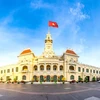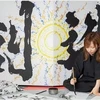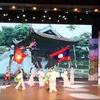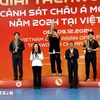 Grapefruit flower baskets have appeared on Hanoi’s streets and at its market stalls, bathing the capital in a sweet scent. Grapefruit trees that grow abundantly in northern Vietnam blossom in February and March and their flowers are brought to markets in Hanoi. Bicycles carrying the flowers with their white petals, golden pistils and deep green leaves meander through Hanoi streets and alleys, beautifying the capital and releasing their gentle fragrance into the spring air. According to traders, from the beginning to the end of March the flowers sell for some 15,000-30,000 VND a bunch. Grapefruit flowers are taken from trees producing too many flowers, mainly from Hanoi’s surrounding localities such as Hung Yen and Bac Ninh provinces, with the pruning designed to achieve higher quality fruits in the future. The flowers are brought home for decoration, and can be added to tea or kudzu soup to increase flavor. (Photo: VietnamPlus)
Grapefruit flower baskets have appeared on Hanoi’s streets and at its market stalls, bathing the capital in a sweet scent. Grapefruit trees that grow abundantly in northern Vietnam blossom in February and March and their flowers are brought to markets in Hanoi. Bicycles carrying the flowers with their white petals, golden pistils and deep green leaves meander through Hanoi streets and alleys, beautifying the capital and releasing their gentle fragrance into the spring air. According to traders, from the beginning to the end of March the flowers sell for some 15,000-30,000 VND a bunch. Grapefruit flowers are taken from trees producing too many flowers, mainly from Hanoi’s surrounding localities such as Hung Yen and Bac Ninh provinces, with the pruning designed to achieve higher quality fruits in the future. The flowers are brought home for decoration, and can be added to tea or kudzu soup to increase flavor. (Photo: VietnamPlus)  Late-February and Early-March is also the season when the grapefruit flowers are in full bloom. Amid the bustle of the new day, the hustle of the daily life, the enchanting scent of grapefruit blossoms draws passerby who might want to stop for a moment, just to breath in the gentle fragrance in the air. The flowers as well as the fruit itself have numerous other uses. Grapefruit essential oil is extracted directly from grapefruit peel, grapefruit or grapefruit flower without losing the natural nutrients of grapefruits. Grapefruit essential oil has a wide range of uses due to its uplifting, stimulating and cleansing properties. (Photo: VietnamPlus)
Late-February and Early-March is also the season when the grapefruit flowers are in full bloom. Amid the bustle of the new day, the hustle of the daily life, the enchanting scent of grapefruit blossoms draws passerby who might want to stop for a moment, just to breath in the gentle fragrance in the air. The flowers as well as the fruit itself have numerous other uses. Grapefruit essential oil is extracted directly from grapefruit peel, grapefruit or grapefruit flower without losing the natural nutrients of grapefruits. Grapefruit essential oil has a wide range of uses due to its uplifting, stimulating and cleansing properties. (Photo: VietnamPlus)  It is highly effective when used in massage blends to treat cellulite and the elimination of toxins because it helps to stimulate the lymphatic system. In skincare, it can be used to help treat oily and congested skin and has an all-round toning effect on dull skin. In common with most citrus oils, grapefruit has an antiseptic and antiviral action that can be used to protect against chills and colds. Vaporizing it helps kill airborne bacteria and prevent germs from spreading. Some even believe the oil is useful for maintaining concentration whilst driving. It is also considered effective in relieving stress, especially when blended with other emotionally stimulating oils such as sweet basil. (Photo: VietnamPlus)
It is highly effective when used in massage blends to treat cellulite and the elimination of toxins because it helps to stimulate the lymphatic system. In skincare, it can be used to help treat oily and congested skin and has an all-round toning effect on dull skin. In common with most citrus oils, grapefruit has an antiseptic and antiviral action that can be used to protect against chills and colds. Vaporizing it helps kill airborne bacteria and prevent germs from spreading. Some even believe the oil is useful for maintaining concentration whilst driving. It is also considered effective in relieving stress, especially when blended with other emotionally stimulating oils such as sweet basil. (Photo: VietnamPlus)  Late-February and Early-March is also the season when the grapefruit flowers are in full bloom. The flowers are brought home for decoration, and can be added to tea or kudzu soup to increase flavor. It requires a complicated and time-consuming process to make grapefruit flower tea the traditional way. The best tea used to make grapefruit flower tea should be from Tan Cuong commune, the northern province of Thai Nguyen. Tan Cuong tea scores high in the international market. This highland district is well-known in Vietnam for its cultivation of aromatic tea for 100 years. This special product from Cuong commune possesses a delicious taste that can mesmerise even the choosiest tea drinkers. The first sip leaves a bitter taste on the tip of the tongue, but that taste immediately transforms into a deep sweet flavour when the tea is swallowed. (Photo: Vietnamplus)
Late-February and Early-March is also the season when the grapefruit flowers are in full bloom. The flowers are brought home for decoration, and can be added to tea or kudzu soup to increase flavor. It requires a complicated and time-consuming process to make grapefruit flower tea the traditional way. The best tea used to make grapefruit flower tea should be from Tan Cuong commune, the northern province of Thai Nguyen. Tan Cuong tea scores high in the international market. This highland district is well-known in Vietnam for its cultivation of aromatic tea for 100 years. This special product from Cuong commune possesses a delicious taste that can mesmerise even the choosiest tea drinkers. The first sip leaves a bitter taste on the tip of the tongue, but that taste immediately transforms into a deep sweet flavour when the tea is swallowed. (Photo: Vietnamplus)  Vietnam’s traditional tea art is neither sophisticated like the Japanese tea art nor complicated like the Chinese one. It is simple but elegant. A cup of tea is always a good way to start a conversation, and a good pot of tea provides a wonderful time to strengthen family bonds or friendship. Tea has been an essential part of Vietnamese life for thousands of years. It is believed that the refreshing beverage not only calms the mind, but also helps ward off a number of common diseases. Tea drinking is a daily habit of Vietnamese. Tea is served at formal and informal meetings, during meals and a gathering of friends. Offering a cup of tea also expresses hospitality and friendliness. When talking about tea and the place of perfect tea products, most Vietnamese people mention Hanoi with the grapefruit flower tea. (Photo: VietnamPlus)
Vietnam’s traditional tea art is neither sophisticated like the Japanese tea art nor complicated like the Chinese one. It is simple but elegant. A cup of tea is always a good way to start a conversation, and a good pot of tea provides a wonderful time to strengthen family bonds or friendship. Tea has been an essential part of Vietnamese life for thousands of years. It is believed that the refreshing beverage not only calms the mind, but also helps ward off a number of common diseases. Tea drinking is a daily habit of Vietnamese. Tea is served at formal and informal meetings, during meals and a gathering of friends. Offering a cup of tea also expresses hospitality and friendliness. When talking about tea and the place of perfect tea products, most Vietnamese people mention Hanoi with the grapefruit flower tea. (Photo: VietnamPlus) 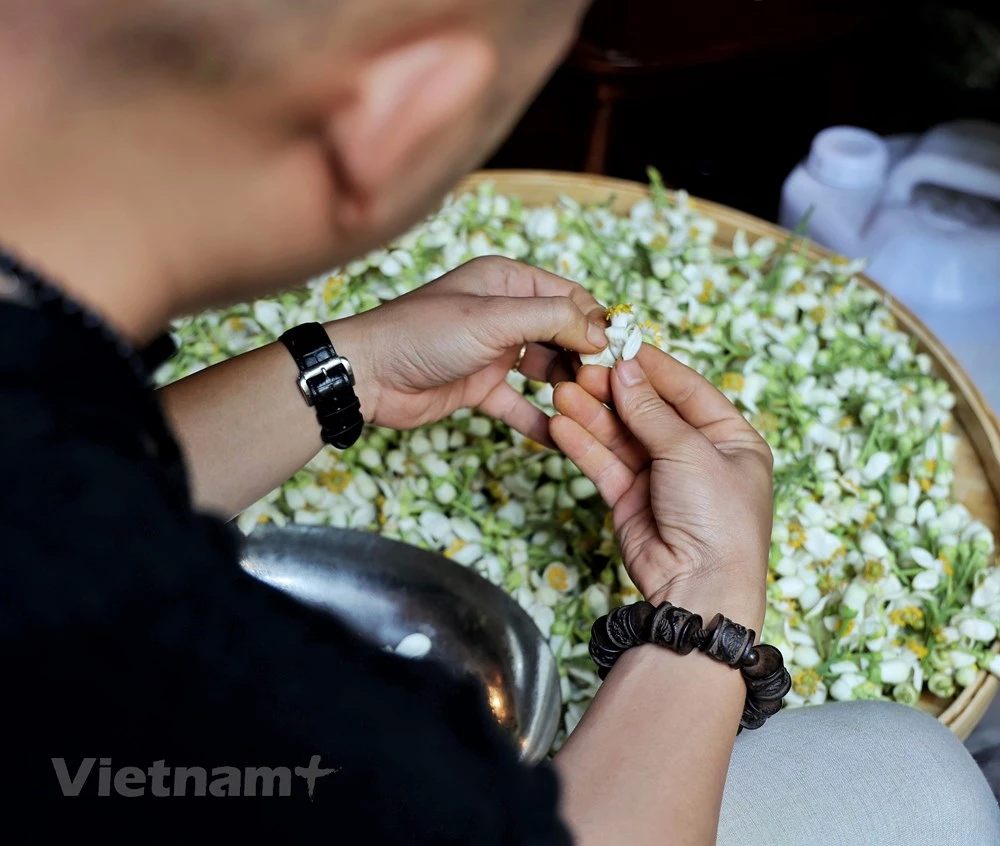 It requires a complicated and time-consuming process to make grapefruit tea the traditional way. Possessing a delicious taste, Tan Cuong teas complement the grapefruit fragrance, which can mesmerise even the choosiest tea drinkers, according to tea artisans in Hanoi. The selection of grapefruit also requires great care. While grapefruit flowers can be found anywhere, artisans choose fresh flowers which are non-fertilised ones to ensure a clean and safe tea pot. Tea drinking is an integral part of Vietnamese culture. Present everywhere from holidays to weddings tea brings friends and family together in conversation and celebration. The Vietnamese often take tea, betel or a cigarette as a prelude to conversation as conveyed by the folk saying that says "a quid of betel and areca-nut starts the ball rolling". (Photo: VietnamPlus)
It requires a complicated and time-consuming process to make grapefruit tea the traditional way. Possessing a delicious taste, Tan Cuong teas complement the grapefruit fragrance, which can mesmerise even the choosiest tea drinkers, according to tea artisans in Hanoi. The selection of grapefruit also requires great care. While grapefruit flowers can be found anywhere, artisans choose fresh flowers which are non-fertilised ones to ensure a clean and safe tea pot. Tea drinking is an integral part of Vietnamese culture. Present everywhere from holidays to weddings tea brings friends and family together in conversation and celebration. The Vietnamese often take tea, betel or a cigarette as a prelude to conversation as conveyed by the folk saying that says "a quid of betel and areca-nut starts the ball rolling". (Photo: VietnamPlus)  After being picked, the petals are quickly separated from the flower before it withers and loses fragrance. The petals are then mixed with high grade dried green tea. For every layer of tea, a layer of fresh grapefruit petals must be laid down. As a specialty of Hanoi, a cup of grapefruit flower tea is a good way to start conversation, and a good pot of tea provides a wonderful time to strengthen family bonds and friendship. Tea has been an essential part of Vietnamese life for thousands of years. It is believed that the refreshing beverage not only calms the mind, but also helps ward off a number of common diseases. (Photo: VietnamPlus)
After being picked, the petals are quickly separated from the flower before it withers and loses fragrance. The petals are then mixed with high grade dried green tea. For every layer of tea, a layer of fresh grapefruit petals must be laid down. As a specialty of Hanoi, a cup of grapefruit flower tea is a good way to start conversation, and a good pot of tea provides a wonderful time to strengthen family bonds and friendship. Tea has been an essential part of Vietnamese life for thousands of years. It is believed that the refreshing beverage not only calms the mind, but also helps ward off a number of common diseases. (Photo: VietnamPlus)  ‘It depends on the experience of each artisan, or the habitat of each family to decide the ratio of Tan Cuong tea and grapefruit petals. However, the ratio must ensure a distinctive taste to the tea’, according to young artisan Nguyen Viet Hung. There are many aspects of tea culture worth noting. The therapeutic and medicinal functions of tea are well known and in hot weather, hot tea is devoured for its surprising cooling effect, and in cold weather for its warmth. There are many types of tea in Vietnam, each with its own unique flavour and properties. Tea cultivation, the history of tea in Vietnam, its relationship to the environment, its economic impact on the ethnic minorities who grow it, the aesthetic aspects and social importance of tea-drinking rituals, could all provide topics for extensive research. (Photo: VietnamPlus)
‘It depends on the experience of each artisan, or the habitat of each family to decide the ratio of Tan Cuong tea and grapefruit petals. However, the ratio must ensure a distinctive taste to the tea’, according to young artisan Nguyen Viet Hung. There are many aspects of tea culture worth noting. The therapeutic and medicinal functions of tea are well known and in hot weather, hot tea is devoured for its surprising cooling effect, and in cold weather for its warmth. There are many types of tea in Vietnam, each with its own unique flavour and properties. Tea cultivation, the history of tea in Vietnam, its relationship to the environment, its economic impact on the ethnic minorities who grow it, the aesthetic aspects and social importance of tea-drinking rituals, could all provide topics for extensive research. (Photo: VietnamPlus)  Beside unscented green tea, teas with the scent of flowers are unique examples of Vietnamese tea culture. The whole process is made by hand, in a very careful manner to transmit the natural scent into the tea. Besides lotus and jasmine flower tea, grapefruit flower tea is an excellent drink in Hanoi. It requires a complicated and time-consuming process to make grapefruit tea the traditional way. Possessing a delicious taste, Tan Cuong teas complement the grapefruit fragrance, which can mesmerise even the choosiest tea drinkers, according to tea artisans in Hanoi. The selection of grapefruit also requires great care. While grapefruit flowers can be found anywhere, artisans choose fresh flowers which are non-fertilised ones to ensure a clean and safe tea pot. (Photo: VietnamPlus)
Beside unscented green tea, teas with the scent of flowers are unique examples of Vietnamese tea culture. The whole process is made by hand, in a very careful manner to transmit the natural scent into the tea. Besides lotus and jasmine flower tea, grapefruit flower tea is an excellent drink in Hanoi. It requires a complicated and time-consuming process to make grapefruit tea the traditional way. Possessing a delicious taste, Tan Cuong teas complement the grapefruit fragrance, which can mesmerise even the choosiest tea drinkers, according to tea artisans in Hanoi. The selection of grapefruit also requires great care. While grapefruit flowers can be found anywhere, artisans choose fresh flowers which are non-fertilised ones to ensure a clean and safe tea pot. (Photo: VietnamPlus)  There are many aspects of tea culture worth noting. The therapeutic and medicinal functions of tea are well known and in hot weather, hot tea is devoured for its surprising cooling effect, and in cold weather for its warmth. There are many types of tea in Vietnam, each with its own unique flavour and properties. Tea cultivation, the history of tea in Viet Nam, its relationship to the environment, its economic impact on the ethnic minorities who grow it, the aesthetic aspects and social importance of tea-drinking rituals, could all provide topics for extensive research. Beside unscented green tea, teas with the scent of flowers are unique examples of Vietnamese tea culture. The whole process is made by hand, in a very careful manner to transmit the natural scent into the tea. (Photo: VietnamPlus)
There are many aspects of tea culture worth noting. The therapeutic and medicinal functions of tea are well known and in hot weather, hot tea is devoured for its surprising cooling effect, and in cold weather for its warmth. There are many types of tea in Vietnam, each with its own unique flavour and properties. Tea cultivation, the history of tea in Viet Nam, its relationship to the environment, its economic impact on the ethnic minorities who grow it, the aesthetic aspects and social importance of tea-drinking rituals, could all provide topics for extensive research. Beside unscented green tea, teas with the scent of flowers are unique examples of Vietnamese tea culture. The whole process is made by hand, in a very careful manner to transmit the natural scent into the tea. (Photo: VietnamPlus)  Since grapefruit flowers’ anther contain a large amount of essential oil, it should not be thrown away but can be used as a material to improve people’s health. The essential oil has distinct properties that may offer a variety of health benefits, including reducing blood pressure and stress levels. Grapefruit oil is naturally high in antioxidants and phytochemicals that reduce oxidative stress and disease-causing inflammation. Many of grapefruit essential oil’s benefits are due to one of its main constituents called limonene (which makes up about 88 percent to 95 percent of the oil). Most commonly, grapefruit oil is used to fight throat and respiratory infections, fatigue, muscle aches, as well as a natural remedy for arthritis. (Photo: VietnamPlus)
Since grapefruit flowers’ anther contain a large amount of essential oil, it should not be thrown away but can be used as a material to improve people’s health. The essential oil has distinct properties that may offer a variety of health benefits, including reducing blood pressure and stress levels. Grapefruit oil is naturally high in antioxidants and phytochemicals that reduce oxidative stress and disease-causing inflammation. Many of grapefruit essential oil’s benefits are due to one of its main constituents called limonene (which makes up about 88 percent to 95 percent of the oil). Most commonly, grapefruit oil is used to fight throat and respiratory infections, fatigue, muscle aches, as well as a natural remedy for arthritis. (Photo: VietnamPlus)  Grapefruit flower tea can be marinated in carton box, pot or ceramic jar. Throughout the process of tea marination, tea leaves and grapefruit flower petal are arranged in layers and turned every two hours in two days for adequate exposure to air and inspection. “It depends on the experience of each artisan, or the habitat of each family to decide the ratio of Tan Cuong tea and grapefruit petals. However, the ratio must ensure a distinctive taste to the tea”, according to young artisan Nguyen Viet Hung. There are many aspects of tea culture worth noting. The therapeutic and medicinal functions of tea are well known and in hot weather, hot tea is devoured for its surprising cooling effect, and in cold weather for its warmth. (Photo: VietnamPlus)
Grapefruit flower tea can be marinated in carton box, pot or ceramic jar. Throughout the process of tea marination, tea leaves and grapefruit flower petal are arranged in layers and turned every two hours in two days for adequate exposure to air and inspection. “It depends on the experience of each artisan, or the habitat of each family to decide the ratio of Tan Cuong tea and grapefruit petals. However, the ratio must ensure a distinctive taste to the tea”, according to young artisan Nguyen Viet Hung. There are many aspects of tea culture worth noting. The therapeutic and medicinal functions of tea are well known and in hot weather, hot tea is devoured for its surprising cooling effect, and in cold weather for its warmth. (Photo: VietnamPlus)  After being picked, the petals are quickly separated from the flower before it withers and loses fragrance. The petals are then mixed with high grade dried green tea. For every layer of tea, a layer of fresh grapefruit petals must be laid down. As a specialty of Hanoi, a cup of grapefruit flower tea is a good way to start conversation, and a good pot of tea provides a wonderful time to strengthen family bonds and friendship. Tea has been an essential part of Vietnamese life for thousands of years. It is believed that the refreshing beverage not only calms the mind, but also helps ward off a number of common diseases. (Photo: VietnamPlus)
After being picked, the petals are quickly separated from the flower before it withers and loses fragrance. The petals are then mixed with high grade dried green tea. For every layer of tea, a layer of fresh grapefruit petals must be laid down. As a specialty of Hanoi, a cup of grapefruit flower tea is a good way to start conversation, and a good pot of tea provides a wonderful time to strengthen family bonds and friendship. Tea has been an essential part of Vietnamese life for thousands of years. It is believed that the refreshing beverage not only calms the mind, but also helps ward off a number of common diseases. (Photo: VietnamPlus)  Drying up the grapefruit flower tea at the temperature of 90-100 degrees Celsius is the last process. Artisans will let it cool off before packaging. Late-February and Early-March is also the season when the grapefruit flowers are in full bloom. The flowers are brought home for decoration, and can be added to tea or kudzu soup to increase flavor. It requires a complicated and time-consuming process to make grapefruit flower tea the traditional way. The best tea used to make grapefruit flower tea should be from Tan Cuong commune, the northern province of Thai Nguyen. Tan Cuong tea scores high in the international market. This highland district is well-known in Vietnam for its cultivation of aromatic tea for 100 years. This special product from Cuong commune possesses a delicious taste that can mesmerise even the choosiest tea drinkers. (Photo: VietnamPlus)
Drying up the grapefruit flower tea at the temperature of 90-100 degrees Celsius is the last process. Artisans will let it cool off before packaging. Late-February and Early-March is also the season when the grapefruit flowers are in full bloom. The flowers are brought home for decoration, and can be added to tea or kudzu soup to increase flavor. It requires a complicated and time-consuming process to make grapefruit flower tea the traditional way. The best tea used to make grapefruit flower tea should be from Tan Cuong commune, the northern province of Thai Nguyen. Tan Cuong tea scores high in the international market. This highland district is well-known in Vietnam for its cultivation of aromatic tea for 100 years. This special product from Cuong commune possesses a delicious taste that can mesmerise even the choosiest tea drinkers. (Photo: VietnamPlus)  Vietnamese tea drinking is simpler than the Chinese or Japanese, but it bears the essence of Vietnamese culture. The yellow and green of the tea and the natural scent of flowers symbolise the country, rich in culture and natural resources. Bitterness at the beginning reflects the hard-working life of the people. The sweet and cool taste that lingers evokes the Vietnamese soul, sentimental and faithful. A tea course requires a brazier, a boiling pot, an earthenware pot of cold water (usually rain water, and in special occasions some dew gathered from lotus leaves), a tea pot, teacups, tea box and a few pieces of aloe and aromatic wood. (Photo: VietnamPlus)
Vietnamese tea drinking is simpler than the Chinese or Japanese, but it bears the essence of Vietnamese culture. The yellow and green of the tea and the natural scent of flowers symbolise the country, rich in culture and natural resources. Bitterness at the beginning reflects the hard-working life of the people. The sweet and cool taste that lingers evokes the Vietnamese soul, sentimental and faithful. A tea course requires a brazier, a boiling pot, an earthenware pot of cold water (usually rain water, and in special occasions some dew gathered from lotus leaves), a tea pot, teacups, tea box and a few pieces of aloe and aromatic wood. (Photo: VietnamPlus)  16. The host will boil the water for a few minutes, then take it off the fire and let the temperature drop to about 90 degrees Celsius. It is poured gently into the teapot, and then cover tightly for about five minutes. While the tea is stewing, tea connoisseurs will comment on the fine aroma of the tea, always keeping the tea as the focus of the conversation, as you would do at a wine tasting. From the teapot, the tea is poured into a large cup called a soldier-cup. This procedure ensures an even distribution of the tea's flavour and colour. If it were poured directly into each cup, the first cup would be more diluted than the last. As you sip the tea, discuss its taste and the mood it brings to you. Poetry is always a good subject at the tea course, but nothing of the past, nothing of the future. The subject belongs only to the present. (Photo: VietnamPlus).
16. The host will boil the water for a few minutes, then take it off the fire and let the temperature drop to about 90 degrees Celsius. It is poured gently into the teapot, and then cover tightly for about five minutes. While the tea is stewing, tea connoisseurs will comment on the fine aroma of the tea, always keeping the tea as the focus of the conversation, as you would do at a wine tasting. From the teapot, the tea is poured into a large cup called a soldier-cup. This procedure ensures an even distribution of the tea's flavour and colour. If it were poured directly into each cup, the first cup would be more diluted than the last. As you sip the tea, discuss its taste and the mood it brings to you. Poetry is always a good subject at the tea course, but nothing of the past, nothing of the future. The subject belongs only to the present. (Photo: VietnamPlus). VNA

